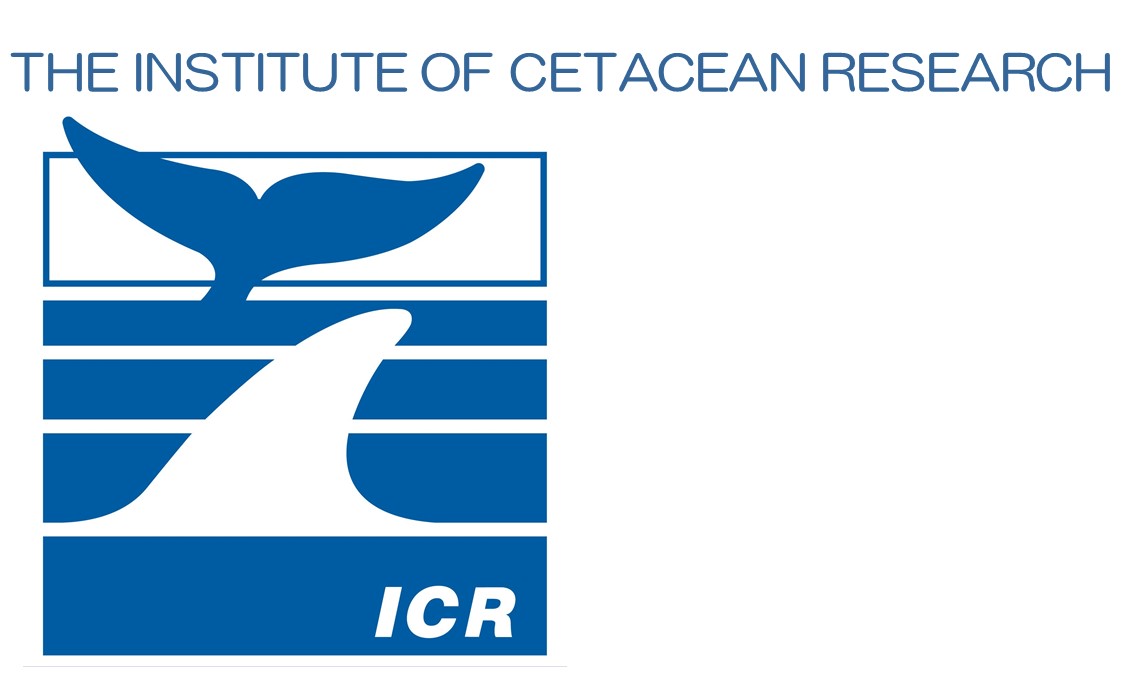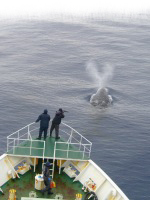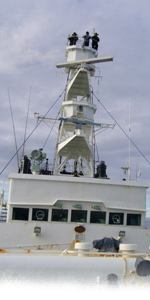- You are here:
- Home>
- English Sitemap>
- RESEARCH>
- Past Research>
- Antarctic Ocean>
- JARPAII
JARPAII outline
The Institute of Cetacean Research (ICR) considered the reports and its suggestions of the International Whaling Commission Scientific Committee(IWC SC) JARPA final review workshop and took them into account to a greater or lesser extent in the development of research objectives of JARPAII.
Objectives
Objective 1
Monitoring the Antarctic ecosystem
ICR considered that the pattern of changes in some biological parameters of the Antarctic minke whale found by its analyses of JARPA data and the changes observed in the abundance of other large whale species, was consistent with the hypothesis of a recent major shift in the Antarctic ecosystem. In developing Objective 1 of JARPAII, ICR therefore focused on monitoring temporal trends in the following key parameters identified during JARPA research that could be considered as ‘indicators’ of changes in the ecosystem:
(1) whale abundance and distribution based on sighting data;
(2) age at sexual maturity and pregnancy rate based on age and reproductive data;
(3) recruitment rate based on age and abundance data;
(4) body condition based on blubber thickness data;
(5) stomach content weight;
(6) contaminant load based on mercury and PCB data;
(7) oceanography based on temperature and salinity profiles.
Given the focus of the research on species interaction in the Antarctic ecosystem, JARPAII considered additional whale species as target of the lethal sampling.
Objective 2
Modelling competition among whale species
JARPA research had found signs of recovery of several large whale species. As a result, it could be hypothesized that krill had become less available for species like the Antarctic minke whale that were thought by many to have benefitted from an apparent ‘krill surplus’ in the middle of the 20th Century due to the major decline in the abundance of the larger whales. Thus, it was plausible that the deteriorated nutritional condition of Antarctic minke whales found through the earlier JARPA research was either: (a) an effect of interspecific competition for krill or (b) an effect of environmental changes. The initial aim was to obtain data to facilitate the development of models to simulate competition among whale species that might determine whether predator-prey interactions alone can explain the observed population trends of whale species (and the biological effects observed in the Antarctic minke whale) in recent decades without the need for recourse to environmental change hypotheses.
The development of such a model was a first step before the long-term goal of the development of revised management policy based on ecosystem considerations. Some of the input data for ecosystem model development from JARPA/JARPAII research were: stomach content of Antarctic minke whales; biomass of krill; and abundance of large whale species. Other information was obtained from the literature.
Objective 3
Elucidation of temporal and spatial changes in stock structure.
The analyses of genetic and morphometric data under JARPA had suggested the occurrence of at least two biological stocks of the Antarctic minke whale in the JARPA research area. The data also suggested an area of transition in the region around 150°-165°E across which there was an undetermined level and range of mixing. The aim of the JARPAII under Objective 3 was to update the earlier analyses using new genetic information obtained under JARPAII, and then to estimate the annual distribution and mixing proportions of the two stocks in the transition region.
Objective 4
Improving the management procedure for Antarctic minke whale stocks under the RMP.
This objective would be met largely by integrating the results under the other three objectives. This objective was divided into two parts: (a) implementation of the current RMP with reduced uncertainty in key factors such as abundance, stock structure and MSYR; and (b) contribution to future improvement of the RMP e.g. by incorporation of a smaller (and possibly species-specific) range of MSY rate values into the RMP and incorporation of multi-species considerations after the development of the ecosystem model.
The figure below shows the interaction among JARPAII research objectives.
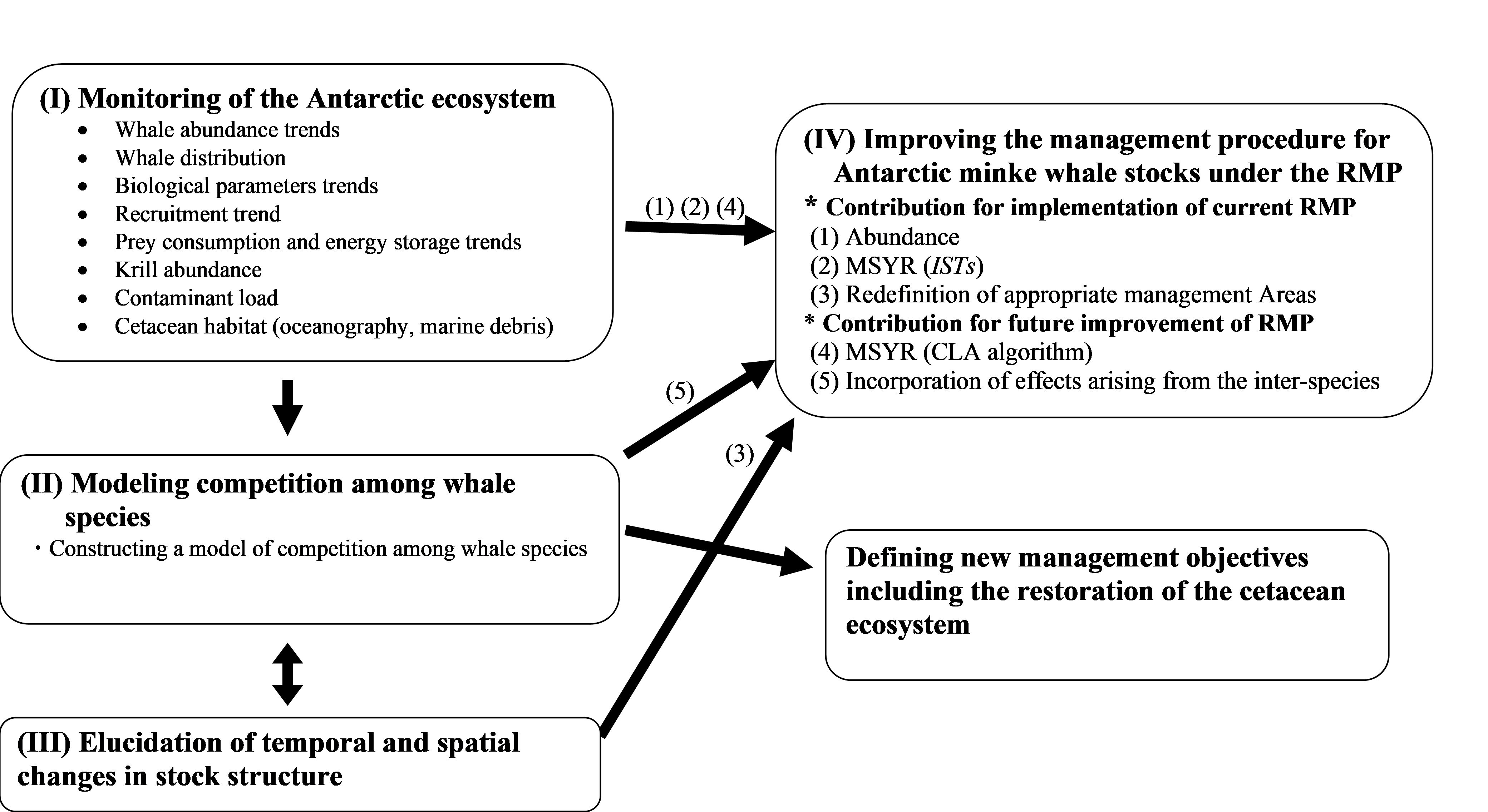
Research area and period
As for JARPA, JARPAII started with a two-year feasibility study (2005/06 and 2006/07) with respect to operating in the expanded research area with an enlarged number of target species. Full scale research commenced from the 2007/08 season. JARPAII was initially designed as a long-term research program of undetermined duration, to be reviewed by the IWC SC every six years. JARPAII was halted after the 2013/14 austral summer season following a Government of Japan (GOJ) decision after the Judgement of the International Court of Justice (ICJ) on the case ‘Whaling in the Antarctic (Australia v. Japan)’ (see NEWREP-A).
The research area covered by JARPAII was the same as in later JARPA: the eastern part of Area III, Areas IV and V, and the western part of Area VI (see figure below). The surveys were conducted each year alternating between the west (35°E-175°E) and the east (130°E-145°W). The area from 130°E and 175°E was covered every year to study the pattern of the mixing of the two stocks.
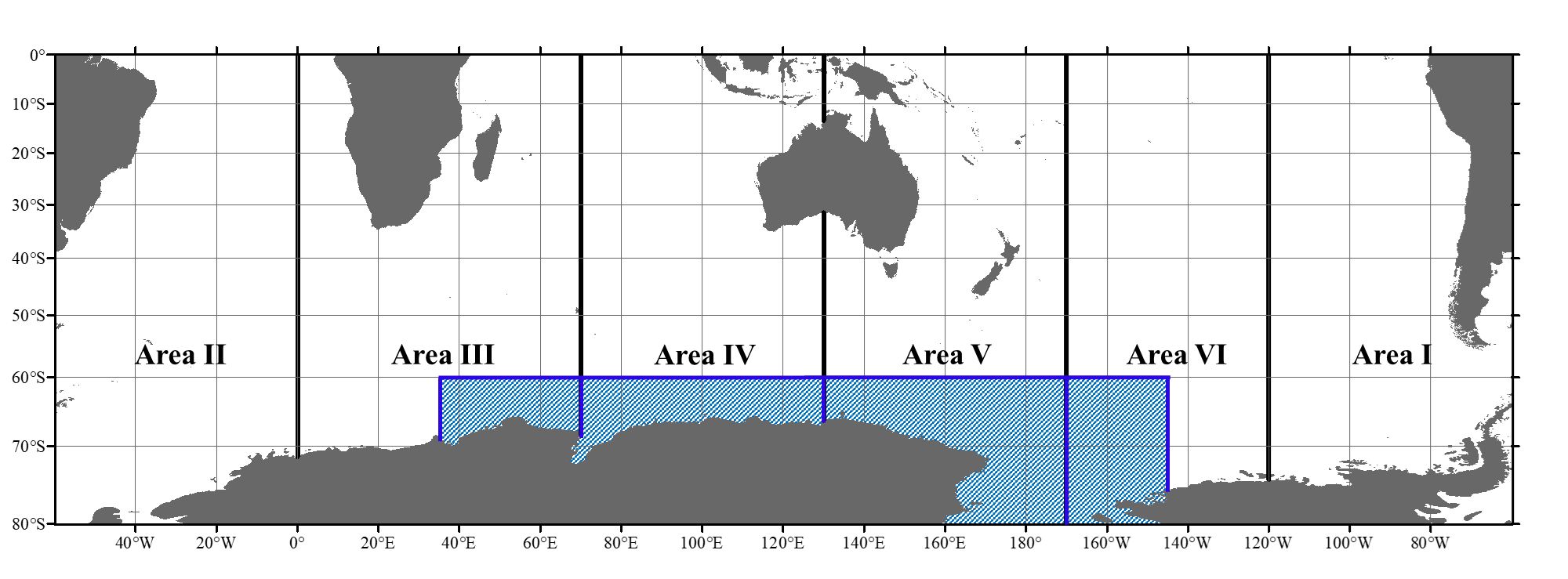
Sample sizes and actual catches
The annual sample sizes and the actual catches of JARPAII are shown in the table below. The sample sizes for the two-year (2005/06-2006/07) feasibility study was 850+/- 10% Antarctic minke whales, 10 fin whales and 0 humpback whales. For the full surveys the sample sizes for fin and humpback whales increased to 50. No humpback whale was taken during the period of this program due to political considerations. The additional target whale species and the larger sample sizes in comparison with JARPA were required by the new research objectives of JARPAII, in particular, the objectives relating to ecosystem research and the construction of a model of multi-species competition.
| Season | Antarctic minke whale | Fin whale | Humpback whale | |||
| Sample size | Catches* | Sample size | Catches | Sample size | Catches | |
| 2005/06(F) | 850+/-10% | 853 | 10 | 10 | 0 | - |
| 2006/07(F) | 850+/-10% | 505 | 10 | 3 | 0 | - |
| 2007/08 | 850+/-10% | 551 | 50 | 0 | 50 | 0 |
| 2008/09 | 850+/-10% | 679 | 50 | 1 | 50 | 0 |
| 2009/10 | 850+/-10% | 506 | 50 | 1 | 50 | 0 |
| 2010/11 | 850+/-10% | 170 | 50 | 2 | 50 | 0 |
| 2011/12 | 850+/-10% | 266 | 50 | 1 | 50 | 0 |
| 2012/13 | 850+/-10% | 103 | 50 | 0 | 50 | 0 |
| 2013/14 | 850+/-10% | 251 | 50 | 0 | 50 | 0 |
F: feasibility study.
*: the number of actual catches were generally smaller than the proposed sample size, which is more evident in the last three seasons. This was due to harassment of the research vessels by radical environmental groups.
Review of JARPAII research proposal and results
The original proposal was presented and discussed at the 2005 IWC SC annual meeting (Doc. SC/57/O1), following the IWC SC’s ‘Old Review Procedure’. Under this procedure the IWC SC reviewed and commented proposals and results either during its annual meeting or by holding intersessional review meetings or workshop open to participation of scientists from all country governments of the IWC as well as invited participants.
The IWC SC carried out a workshop to review JARPAII results for its first six years (2005/06-2010/11) based on the ‘New Review Procedure’(see table below). This new procedure was developed by the IWC SC in 2008 to increase the level of consensus. The most important component of the new procedure was an Expert Panel workshop, with specific Terms of References for both review of new proposals and review of research results from existing and completed special permit research programs. The workshops had open and closed sessions and scientists from the Contracting Government participated only in the open sessions to present research proposal and results, and to answer points of clarification from the Panel.
| JARPAII | |
| 2014(Existing) | |
| Date | 24-28 February |
| Place | Tokyo |
| Chair | Debra Palka(USA) |
| No. international Review Panel | 9 (Spain, UK, Norway, USA, IWC Secretariat) |
| No. Japanese proponents* | 20 |
| No. observers* | 5 (Australia, Norway, USA, South Africa) |
| No. primary documents by proponents | 38 |
| No. other documents** | 8 |
| No. response documents by proponents*** | 5 |
| For Information documents | 0 | Reference | IWC, 2015 pp367**** |
*: proponents and observers participated only in the open sessions of the workshop, i.e., not in Panel discussions and deliberations.
**: documents prepared by Review Panel members and observers.
***: documents prepared by the proponents in response to documents prepared by observers.
****: International Whaling Committion, 2015. Report of the Expert Workshop to Review Japanese JARPAII Spacial Reseach Program.J.Cetacean Res. Manage. 16(Suppl.): 367-409.
There was a comprehensive sample and data set obtained by JARPAII (see details in IWC, 2015 pp408).
The JARPAII program started in austral summer season 2005/06 and 2006/07 as a two-year feasibility survey.The full program started in 2007/08 as a long-term research program of undetermined duration.
It was halted prematurely after season 2013/14 due to a decision of the Government of Japan in response to the International Court of Justice’s Judgement on the Antarctic whaling case.
The JARPAII research objectives were developed based on the finding of JARPA and the recommendations from the IWC SC JARPA final review workshop.
The objectives aimed to understand the changes in the Antarctic marine ecosystem and to improve the IWC SC RMP.
The target species of the lethal component were the Antarctic minke, fin and humpback whales, with annual proposed sample sizes of 850+/- 10%, 50 and 50, respectively.
No humpback whale was taken during the program.
JARPAII proposal and results were duly reviewed and commented by the IWC SC through specific workshops.
